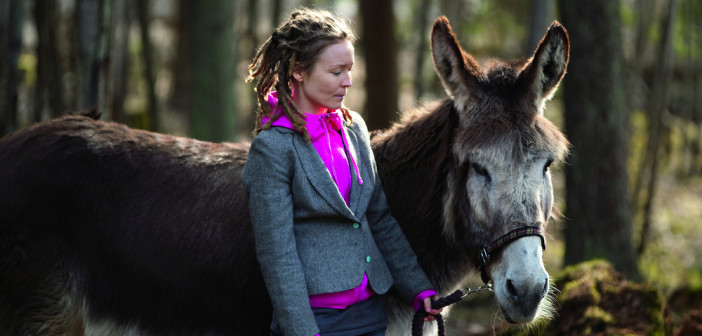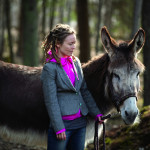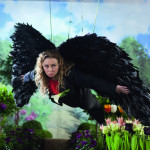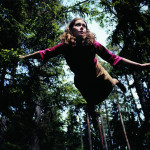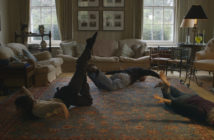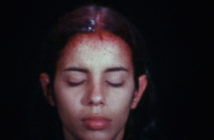In retrospect, it seems only fitting that I should see Finnish artist Eija-Liisa Ahtila’s video installations at the Davis Museum. It’s been years since I last uttered the words "esse is percipi,"1 but those conversations (arguments, really) involving Bishop Berkeley and poor, misguided Samuel Johnson’s rock had started long ago on that verdant campus. If, since then, I’ve wondered how a degree in philosophy might prove useful, Ahtila’s first major US exhibition, the very one to bring me back to Wellesley College all these years later, provides the answer. But that may be the only answer in the slew of insoluble questions it raises about perception and its relation to reality.
There is an intersection, of course, between philosophy, art theory, and art practice. But Eija-Liisa Ahtila’s work begins in the porousness of those disciplinary boundaries. Olentoja (Creatures, for those of us who don’t speak Finnish) is a prolonged investigation of metaphysical and epistemological inquiries through mixed media. What is "reality"? Can objects exist independently of the mind? If they do, how would we ever know? What is it like to experience the world from someone else’s perspective? Is it the same world, time, and space? It’s knotty stuff, but Ahtila unwinds the intricacies in elaborate video installations. Each follows its own thread of inquiry.
In Companions (2011), a 4-minute 10-second loop on three monitors, we are deceived into believing the ostensibly linear narrative before us. Two boys and their dog travel through the seasons in pastoral scenes, sliding down the wintery hillside on red sleds that inevitably crash in a snowbank, or barreling down a summery dock into the open lake. Snow and water splash, marking the temporal changes, and our perception shifts with the speed of their sleds and the underwater world they encounter. Sound is muffled below the surface, where the musical score becomes faint amidst the lily pads. Some ducks emerge in the frame, and we follow them. It all seems so bucolic that I didn’t quite know what to make of it at first.
It is only by wondering who is doing the seeing in these multiple, shifting frames, and when in time, that the underlying investigation reveals itself. This is not Cubism redux. Companions is not merely a viewing from multiple vantage points simultaneously. Rather, the valid question is this: whose perspective are we experiencing? Is it Ahtila’s? Either of the two boys or both? Are we seeing the world through their dog’s eyes, or, as it sometimes seems, through the eyes of a flock of ducks? It is not disembodied vantage points that overlap here, but someone’s embodied field of vision.
Personally, I believe it to be all of the above, and not, as might appear at first blush, in any sequential way. As experimental film, Companions tells its story (or stories) in multiple voices speaking at once. On its own, this might not mean very much. Shifting between and across a multiplicity of viewpoints, with each of three screens progressing according to its own internal clock, does not necessarily tell us anything about the artist’s deeply held beliefs about the nature of reality. But Ahtila presses her point. Her videos explore these same concepts over and over again from different angles.
If I had been led to believe that Ahtila was an Anti-Realist—someone who rejects the position that there is one mind-independent, objective way the world really is—then I was in for a surprise. Eija-Liisa Ahtila is a unique story-teller, not only rejecting narrative but confounding it. Vaakasuora (Horizontal) (2011) takes a different tactic. A six-channel projected installation of a Spruce tree, it has no sequence, no plot whatsoever. Nothing at all happens in Vaakasuora. It is a portrait of a monumental, living tree. By her own admission, Ahtila has tried to represent the Spruce tree as "faithfully" as possible using our inadequate technology for recording. The gallery is deep, vast, and empty. The tree subsumes our view. For scale, a woman stands at its base. We hear its leaves rustling in the wind and the flapping of wings. It is a peaceful scene, but one that raises a troubling prospect.
I would venture to guess that there are few artists who believe they can accurately represent their subject, or even that it should be their aim to try. Photographers are especially sensitive to this misadventure, as we know that photographs are not, and never have been, records of the "truth." If Ahtila wanted to demonstrate the fallibility of our tools, she succeeded: her Spruce tree is comprised of six videos shot at different moments in time, its trunk splicing at the seams between frames as it sways in the wind. And I cannot help but mention the obvious: it is horizontal across the length of the wall.
Vaakasuora is certainly not an accurate record of the Spruce tree. But, more troubling, I could not fathom why an Anti-Realist, why a firm believer that "to be is to be perceived," would attempt a faithful representation in the first place. To what reality does Ahtila believe that representation corresponds? Is it the Spruce tree’s own reality, it scale and magnitude? Is her video portrait an attempt to capture its experience?
Olentoja means "creatures," and it seems Ahtila means it. Her Anthropomorphic Exercises on Film (2011) are a series of cinematic storyboarding that take the mighty Spruce as actor. We are indeed supposed to experience the scenes described in drawing from its perspective of reality, whatever that might be. And that is the crux of the real conceptual problems with her work. As viewers, we can only experience the storyboards and Vaakasuora according to the sensory potential available to us. This too is a familiar complication in analytic philosophy, what lead Thomas Nagel to ask his oft recited question "What is it like to be a bat?" Nagel’s point? We may know everything there is to know about the bat, or Spruce tree, in biological terms, but we can never experience the qualia, or subjective experiences, that they do. In all of Ahtila’s work, despite her disruptive and deconstructive efforts, we are still limited to our own subjectivities.
In Marian Ilmestys (The Annunciation) (2010), Ahtila would like for us to experience miracles, wholly different ways of perceiving. In Medieval and Renaissance paintings, which she couples with a modern-day rehearsal for a Christmas pageant, the holy spirit is depicted as a dove, the benefactor and patron of the artwork as a swallow. In the play within the play, actors become ravens through costumes. But that is where Ahtila’s investigation stops abruptly. She may be a committed Anti-Realist, but there is one reality we cannot surpass: we can never know what it is like to be a bird. We gaze at her video installations from the position of our own chairs, and not through her eyes or anyone else’s, whether actor, pigeon, or actor as raven. The multiplicity of perspectives she wants us to experience is simply beyond our experience. Her artwork, consequently, cannot deliver on its promise.
At fourteen minutes, Talo (The House) (2002) is more successful, wrestling with psychological rather than purely philosophical conundrums. In Talo, we witness a young woman arrive at a cabin in the woods (never a good sign) on the verge of an imminent psychotic break with reality that ultimately transmogrifies into full-blown psychosis. She soon loses the mental mechanism for filtering experiences. Unable to turn off sensory input, her consciousness becomes incoherent, her perspective disjointed. It is no longer clear what is real and what is not, at least from where she stands. The actor confesses that she is now several people. For us as viewers, though, the matter is indeed more clear. We know what is real and what is not. This fact, as subtle as it may be, calls into question Ahtila’s own theoretical position: if hallucinations are perceived but not real, then mustn’t there be objects that are, by distinction, perceived but also what we would call "real"? And what does it mean for them to be real, if the perception of those objects is not the determinant? There are no easy answers in Olentoja. And I have merely scratched the surface of its questions here.
Of course, it’s easy to unpack a problem when you know what you’re after. Eija-Liisa Ahtila has a preconceived solution. She is an Anti-Realist (although she might not use the term) who appears to believe that the multiplicity of her frames proves her point, and it is that glib assumption that trips her up. In her work, we may be presented with multiple perspectives simultaneously, and so with differing realities, in her view, but we are limited in a way she did not anticipate. We can only view Olentoja from one set of eyes, our own. In the end, we impose our own linear narrative on her work, even without trying. But, as any philosopher will tell you, it is more rewarding to ask questions that have questions as answers, after all, and Olentoja does not disappoint in this regard.
- Marian Ilmestys — The Annunciation [screenshot), 2010 28:30 min 3-channel projected installation; 16:9/1:1,78, Dolby Digital 5.1 original language Finnish, English subtitles Courtesy of the Artist and Marian Goodman Gallery, New York and Paris © Antti Ruusuvuori.
- Marian Ilmestys — The Annunciation [screenshot), 2010 28:30 min 3-channel projected installation; 16:9/1:1,78, Dolby Digital 5.1 original language Finnish, English subtitles Courtesy of the Artist and Marian Goodman Gallery, New York and Paris © 2010 Crystal Eye — Kristallisilmä Oy, Helsinki.
- Eija-Liisa Ahtila, The House, 2002, 14 min, DVD installation for 3 projections with sound. Photographed by Marja-Leena Hukkanen. Copyright Crystal Eye Ltd, Helsinki Courtesy of Marian Goodman Gallery, New York and Paris.
- Eija-Liisa Ahtila, Horizontal, 2011. 6 min. 6-channel projected installation; 16:9/1:1,78; Dolby Digital 5.1. No dialogue. Courtesy of Marian Goodman Gallery, New York and Paris. © 2011 Crystal Eye — Kristallisilmä Oy.
[1] Editor's Note: To be is to be perceived.

